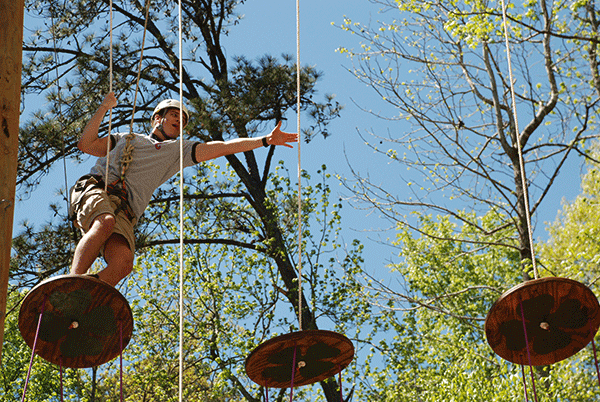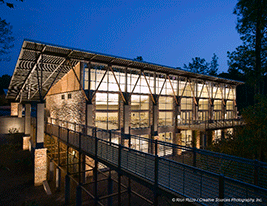
or Science, Technology, Engineering and Math.
By John N. Felsher
An old proverb states: “A man who works with his hands and back is a laborer. A man who works with his hands, back and head is a craftsman. A man who works with his hands, back, head and heart is an artist.”
That saying isn’t the official 4-H motto, but perhaps reflects what the organization tries to instill in young people. For the record, the official 4-H motto is “To make the best better,” with the official slogan as “Learn by doing.”
“The four ‘Hs’ stand for head, heart, hands and health,” explains Dr. Molly Gregg, a 4-H youth development specialist for the Alabama Cooperative Extension System based at Auburn University. “The goal of 4-H is to create places where kids can come to learn by doing while having fun. We hope to provide them with opportunities to master skills that will help them make healthier lifestyle choices in the future. Our primary focus is to ensure that kids live healthy and that they develop the skills they’ll need for the workforce.”
In 2013, more than 121,000 Alabama youths between the ages of 9 and 19 years old participated in such diverse 4-H programs as environmental studies, agriculture, wildlife education, engineering and many more topics. Each year, more than 6.5 million people in 90,000 organizations across America participate in 4-H, the youth component of cooperative extension programs.
“4-H is the largest youth organization in Alabama and the largest youth organization nationally,” explained Maggie Lawrence, an Alabama Cooperative Extension System communications specialist at Auburn University. “It’s free to be a 4-H member, but some activities may have fees. While its roots are in agriculture, 4-H has expanded into science, engineering, robotics and many other programs. There’s a 4-H program for any young person’s interest.”
One in seven adults participated in 4-H in their lives
Across America, one in seven adults participated in a 4-H activity at some point in their lives. Some notable people with 4-H experience include Jacqueline Kennedy Onassis, Julia Roberts, Faith Hill, Johnny Cash, Reba McEntire, Archie Manning, Vice President Al Gore and Orville Redenbacher, the popcorn king among millions of other 4-H alumni.

Administered by the U.S. Department of Agriculture through land-grant institutions like Alabama A&M and Auburn Universities, 4-H began more than 100 years ago as a practical, hands-on way to educate rural youths. As the 19th century drew to a close, older generations of farmers steadfastly maintained their traditional agricultural methods, but emerging technologies could improve their lives and productivity. To teach these older farmers to accept new ideas, the U.S.D.A. came up with ways to teach rural youths who could pass this knowledge to their parents and grandparents.
In 1882, Delaware College organized a contest to see who could grow the best corn in accordance with their instructions. In 1892, groups in Wisconsin began a movement to include youths in various agriculture clubs. Similar efforts, such as tomato and corn clubs, emerged in Ohio, Minnesota and elsewhere by the early 20th century. Many of these clubs and programs formed the foundation for the 4-H experience.
Officially, 4-H came into existence on May 8, 1914, when President Woodrow Wilson signed the Smith-Lever Act. The act created the Cooperative Extension Service with the mission of “promoting agriculture, human health, the environment and well-being in communities.” The act also incorporated various programs under the 4-H umbrella. The 4-H organization pioneered the then-unlikely idea of including boys and girls in the same programs. In 1924, 4-H adapted its iconic four-leaf clover logo.
“4-H started in the agricultural South when parents weren’t willing to make the changes they needed to do to be more economically successful,” Gregg advised. “They taught youths skills so they could teach their parents. We still have agriculture and wildlife programs, but we also have urban and suburban programs. We’re very involved in STEM programs, which stands for Science, Technology, Engineering and Math, plus citizenship, leadership and workforce development. One of our more popular programs is ‘Health Rocks,’ about making good decisions for lifestyle choices.”
Many young people become involved with 4-H through their local schools. In addition, an extension office in every Alabama county can help with 4-H projects. Full-time cooperative extension professionals work closely with volunteers who conduct programs to fill local needs. Regional extension agents serve two counties.
“Extension agents oversee 4-H programs in their two counties and work with volunteers who have undergone extensive training to get certified as 4-H volunteer leaders,” Lawrence said. “Young people can participate in many different disciplines. Our fastest growing program in Alabama is SAFE – Shooting Awareness Fun and Education, where young people can participate in a shooting sports curriculum.”
Volunteers are essential

Volunteers form the backbone of 4-H efforts. These volunteers come from many backgrounds with diverse experiences. Volunteers help with after-school programs, weekend events, summer camps and at other times to pass their experiences and knowledge to new generations. In 2013, nearly 2,900 volunteers in Alabama contributed more than 96,150 hours of time. If they had charged for their services, the value would have exceeded $2.1 million. Nationally, more than 540,000 volunteers donate time to 4-H activities.
“Alabama 4-H represents the face of the state,” Gregg said. “It has rural kids, urban kids, at-risk kids, kids from poor economic areas, all kinds of kids. Many kids get involved through their schools, but most counties have community-based clubs or special interest clubs. Through community service, kids learn that they can make a difference in solving a problem. If kids have an interest, we’re always looking for opportunities to hook them up with caring adults or programs to suit their needs. If young people have a need, we’ll find them.”
No matter the interest or topic, 4-H programs generally stress a sense of belonging, responsiveness, independence, safety, health, mastery of a discipline, hands-on education and generosity to others. Many 4-H alumni become extension professionals or volunteers later in life.
“4-H teaches life skills, but 4-Hers tend to be very involved young people,” Lawrence explained. “Following through on a project is one of the key elements.”
Typically, kids who become involved with 4-H programs do so because they want to learn and experience life, not just watch it on television or a computer. A study conducted by Tuffs University determined that young people involved in 4-H programs are civically active and four times more likely to contribute to their local communities than their peers. They are also twice as likely to participate in afterschool programs involving science or nature and twice as likely to make healthier lifestyle choices for themselves.
“There’s a 4-H project for just about anyone,” Lawrence said. “We have some competitive events where young people who have worked their projects all year can compete at the local and county level. Many go on to compete at the state level. Sometimes, 4-Hers compete beyond state boundaries and interact with peers from other states through national trips and conferences.”
While many young people learn about 4-H programs in school, youths interested in 4-H programs should contact their local county extension office. If they don’t see programs they like, perhaps they could start one. For more information on 4-H in Alabama or a list of county extension office contacts, see www.aces.edu.




